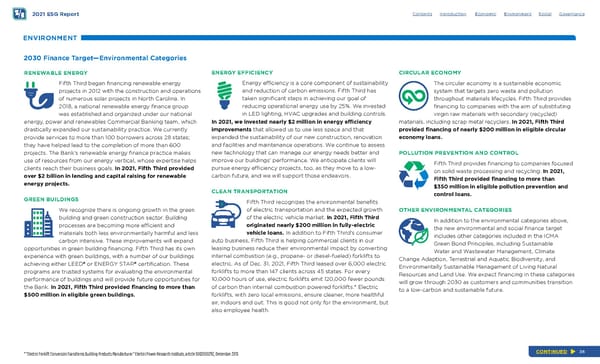2021 ESG Report ENVIRONMENT 2030 Finance Target—Environmental Categories RENEWABLE ENERGY Fifth Third began fnancing renewable energy projects in 2012 with the construction and operations of numerous solar projects in North Carolina. In 2018, a national renewable energy fnance group was established and organized under our national energy, power and renewables Commercial Banking team, which drastically expanded our sustainability practice. We currently provide services to more than 100 borrowers across 28 states; they have helped lead to the completion of more than 600 projects. The Bank’s renewable energy fnance practice makes use of resources from our energy vertical, whose expertise helps clients reach their business goals. In 2021, Fifth Third provided over $2 billion in lending and capital raising for renewable energy projects. GREEN BUILDINGS We recognize there is ongoing growth in the green building and green construction sector. Building processes are becoming more efcient and materials both less environmentally harmful and less carbon intensive. These improvements will expand opportunities in green building fnancing. Fifth Third has its own experience with green buildings, with a number of our buildings achieving either LEED® or ENERGY STAR® certifcation. These programs are trusted systems for evaluating the environmental performance of buildings and will provide future opportunities for the Bank. In 2021, Fifth Third provided fnancing to more than $500 million in eligible green buildings. ENERGY EFFICIENCY Energy efciency is a core component of sustainability and reduction of carbon emissions. Fifth Third has taken signifcant steps in achieving our goal of reducing operational energy use by 25%. We invested in LED lighting, HVAC upgrades and building controls. In 2021, we invested nearly $2 million in energy efciency improvements that allowed us to use less space and that expanded the sustainability of our new construction, renovation and facilities and maintenance operations. We continue to assess new technology that can manage our energy needs better and improve our buildings’ performance. We anticipate clients will pursue energy efciency projects, too, as they move to a low- carbon future, and we will support those endeavors. CLEAN TRANSPORTATION Fifth Third recognizes the environmental benefts of electric transportation and the expected growth of the electric vehicle market. In 2021, Fifth Third originated nearly $200 million in fully-electric vehicle loans. In addition to Fifth Third’s consumer auto business, Fifth Third is helping commercial clients in our leasing business reduce their environmental impact by converting internal combustion (e.g., propane- or diesel-fueled) forklifts to electric. As of Dec. 31, 2021, Fifth Third leased over 6,000 electric forklifts to more than 147 clients across 45 states. For every 10,000 hours of use, electric forklifts emit 120,000 fewer pounds of carbon than internal combustion powered forklifts.* Electric forklifts, with zero local emissions, ensure cleaner, more healthful air, indoors and out. This is good not only for the environment, but also employee health. Contents Introduction Economic Environment Social Governance CIRCULAR ECONOMY The circular economy is a sustainable economic system that targets zero waste and pollution throughout materials lifecycles. Fifth Third provides fnancing to companies with the aim of substituting virgin raw materials with secondary (recycled) materials, including scrap metal recyclers. In 2021, Fifth Third provided fnancing of nearly $200 million in eligible circular economy loans. POLLUTION PREVENTION AND CONTROL Fifth Third provides fnancing to companies focused on solid waste processing and recycling. In 2021, Fifth Third provided fnancing to more than $350 million in eligible pollution prevention and control loans. OTHER ENVIRONMENTAL CATEGORIES In addition to the environmental categories above, the new environmental and social fnance target includes other categories included in the ICMA Green Bond Principles, including Sustainable Water and Wastewater Management, Climate Change Adaption, Terrestrial and Aquatic Biodiversity, and Environmentally Sustainable Management of Living Natural Resources and Land Use. We expect fnancing in these categories will grow through 2030 as customers and communities transition to a low-carbon and sustainable future. *”Electric Forklift Conversion Transforms Building Products Manufacturer” Electric Power Research Institute, article 3002000292, December 2013 CONTINUED 36
 Fifth Third ESG Report Page 35 Page 37
Fifth Third ESG Report Page 35 Page 37